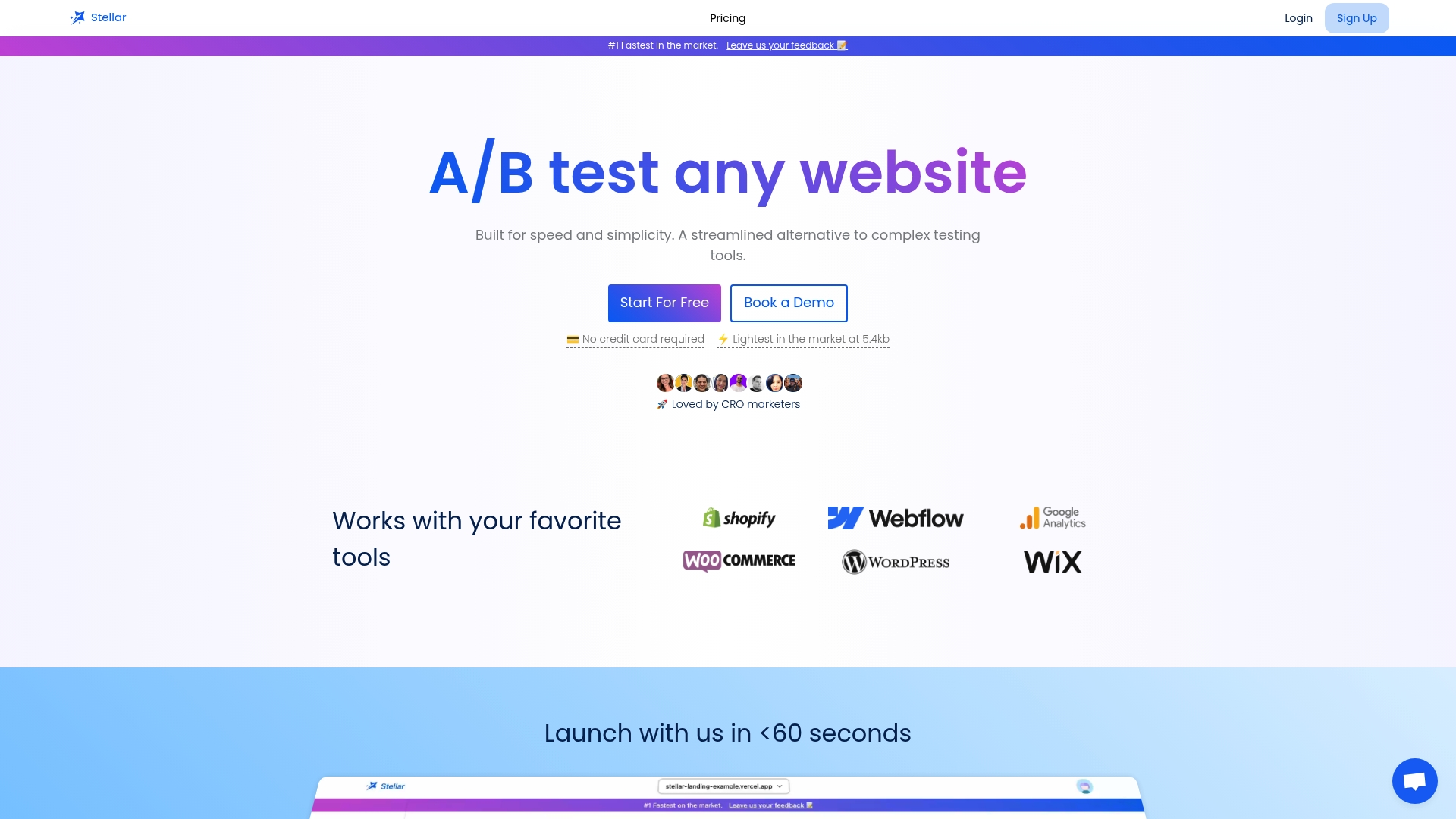
Why Test Landing Pages: Unlock Better Conversions in 2025

Landing page testing might sound like a chore, but it's actually the secret sauce behind modern business growth. Here is a shocker. Targeted landing pages can boost conversion rates by at least 25 percent on average. Most people believe you need a total website overhaul to see big results, yet a few strategic tweaks on a single page can deliver dramatic gains that make all the difference.
Table of Contents
- Understanding The Importance Of Landing Page Testing
- Key Benefits For Cro And Marketing Teams
- Common Testing Methods And Best Practices
- How Testing Drives Business Growth And Roi
Quick Summary
| Takeaway | Explanation |
|---|---|
| Landing page testing is crucial for maximizing conversions | Systematic evaluation of webpage elements can transform visitors into customers and significantly improve conversion rates. |
| Data-driven decision making enhances marketing effectiveness | By analyzing user interactions and preferences, marketing teams can identify psychological triggers and optimize resource allocation strategically. |
| Robust testing methodologies yield actionable insights | Employing various methods like A/B and multivariate testing allows marketers to gather vital data while ensuring statistical significance in results. |
| Continuous improvement is essential | Landing page testing should be an ongoing process, enabling businesses to adapt to user preferences and changing market conditions effectively. |
| Strategic testing impacts ROI and growth | Regularly implementing landing page tests can lead to reduced acquisition costs, improved user experiences, and overall enhanced business performance. |
Understanding the Importance of Landing Page Testing
Landing page testing represents a critical strategy for businesses seeking to maximize their online conversion potential. By systematically evaluating and refining webpage elements, organizations can transform casual visitors into committed customers. According to research published by Massachusetts Institute of Technology, landing page tests serve as a powerful form of Minimum Viable Product (MVP) testing, allowing companies to precisely gauge customer interest and purchase intent.

The Science Behind Conversion Optimization
Understanding landing page testing requires recognizing its fundamental role in digital marketing strategy. Research from arXiv reveals a critical insight: there is a negative correlation between information volume and user engagement. This means that concise, targeted content significantly increases the likelihood of users providing contact information or completing desired actions.
The core principle of landing page testing revolves around data driven decision making. By systematically comparing different versions of a webpage, marketers can uncover subtle yet powerful insights about user behavior. These insights go beyond simple aesthetic preferences, diving deep into psychological triggers that motivate user actions.
Quantifying the Impact of Strategic Testing
Empirical evidence demonstrates the transformative potential of landing page optimization. A compelling study published in the Journal of Medical Internet Research highlighted how strategic testing of landing page elements like infographics and videos can dramatically improve user engagement and completion rates.
Businesses that embrace a rigorous testing approach can expect substantial benefits. By implementing systematic landing page tests, organizations can:
- Reduce Acquisition Costs: Optimize conversion pathways to minimize marketing spend
- Improve User Experience: Create more intuitive and responsive webpage designs
- Increase Revenue: Directly impact bottom line through more effective conversion strategies
The complexity of landing page testing extends beyond simple A/B comparisons. Modern approaches incorporate multivariate testing, heat mapping, and advanced user behavior analytics to provide nuanced insights. Learn more about advanced conversion optimization strategies to stay ahead of emerging digital marketing trends.
Successful landing page testing is not a one time event but an ongoing process of continuous refinement. As user preferences evolve and digital landscapes shift, businesses must remain adaptive, using data as their primary compass for strategic decision making.
By understanding and implementing sophisticated landing page testing methodologies, organizations can transform their digital presence from passive websites into dynamic, high performing conversion engines.
Key Benefits for CRO and Marketing Teams
Conversion rate optimization (CRO) and marketing teams operate in a complex digital environment where every interaction counts. Landing page testing provides strategic advantages that transform how organizations approach digital marketing and user acquisition. Research from Unbounce reveals that implementing targeted landing pages can lead to an average conversion rate improvement of at least 25%, making it a critical strategy for modern marketing professionals.
Precision Performance Measurement
Landing page testing enables marketing teams to move beyond guesswork and embrace data driven decision making. By systematically analyzing user interactions, teams can understand precisely what motivates potential customers. Proof3 research highlights that optimized landing pages which load quickly and provide intuitive navigation significantly enhance user satisfaction, directly reducing bounce rates and increasing conversion potential.
Marketing professionals gain unprecedented insights through comprehensive testing methodologies. These insights allow for granular understanding of user behavior, enabling teams to:
- Identify Psychological Triggers: Uncover what specific elements drive user engagement
- Validate Hypotheses: Test marketing assumptions with concrete data
- Optimize Resource Allocation: Direct marketing budgets toward proven strategies
Strategic Cost Efficiency
Beyond performance metrics, landing page testing delivers substantial economic benefits. Lead Stalk Digital analysis demonstrates that aligning landing page content with advertising copy can reduce cost per click by up to 50%, presenting a compelling financial argument for rigorous testing.
By implementing sophisticated testing protocols, CRO teams can:
- Minimize customer acquisition costs
- Maximize return on marketing investments
- Create more targeted and personalized user experiences
The complexity of modern digital marketing demands agile, responsive strategies. Learn more about advanced conversion optimization techniques to stay competitive in an evolving marketplace.
Ultimately, landing page testing transforms marketing from a speculative practice to a precise, measurable science. Teams that embrace these methodologies position themselves at the forefront of digital marketing innovation, turning data into actionable insights that drive meaningful business growth.
To help clarify the unique advantages landing page testing delivers to CRO and marketing teams, the table below summarizes its key benefits and business impacts:
| Benefit | Description | Source/Stat Highlight |
|---|---|---|
| Increased Conversion Rates | Targeted landing pages can improve conversions by at least 25% | Unbounce, Lead Stalk Digital |
| Reduced Cost Per Click | Aligning landing page content with advertising can decrease cost per click by up to 50% | Lead Stalk Digital |
| Improved User Experience | Fast load times and intuitive navigation reduce bounce rates and boost satisfaction | Proof3 |
| Granular User Behavior Insights | Testing reveals psychological triggers and validates marketing hypotheses | Proof3 |
| Strategic Resource Optimization | Data-driven testing directs budget toward proven strategies | Proof3, MIT |
| Ongoing Adaptation to User Preferences | Continuous testing ensures strategies evolve with market and user changes | Content Summary |
| Maximized Return on Marketing Investment | Enhanced conversions and optimized cost structures lead to improved ROI | Content Summary, Unbounce |
Common Testing Methods and Best Practices

Landing page testing represents a sophisticated approach to digital marketing optimization, with multiple methodologies designed to uncover user preferences and behavioral patterns. A comprehensive review from arXiv analyzing 141 studies reveals that classic A/B testing remains the most prevalent technique, primarily targeting algorithms and visual elements that significantly impact user engagement.
To clarify the differences and applications of common landing page testing methods, the next table offers a concise comparison:
| Testing Method | Description | Primary Uses |
|---|---|---|
| A/B Testing | Compares two versions of a webpage to find which performs better | Headline, layout, CTA |
| Multivariate | Tests multiple page elements and their interactions simultaneously | Headlines, images, forms |
| Split URL | Compares entirely different webpage designs hosted on separate URLs | Full design alternatives |
Strategic Testing Approaches
Effective landing page testing requires a nuanced understanding of different methodological frameworks. Marketers can leverage several core testing methods to gain actionable insights:
- A/B Testing: Comparing two versions of a webpage to determine which performs better
- Multivariate Testing: Simultaneously evaluating multiple page elements and their interactions
- Split URL Testing: Comparing entirely different webpage designs hosted on distinct URLs
Researchers emphasize the critical importance of statistical significance in testing protocols. A rigorous methodology review highlights the need for robust sample sizes and careful variance management to ensure reliable results.
Navigating Testing Complexity
Successful landing page testing goes beyond simple visual comparisons. Research from arXiv demonstrates a crucial insight: information density directly impacts user engagement. Studies involving over 27,900 participants revealed a negative correlation between content volume and users' willingness to provide contact information.
Professional marketers must consider multiple dimensions when designing tests:
- Precise measurement of user interactions
- Statistically significant sample sizes
- Controlled experimental conditions
- Comprehensive data collection and analysis
Advanced testing requires sophisticated tools that minimize performance overhead. Explore performance optimized testing strategies to ensure your optimization efforts do not compromise website speed.
The most effective testing approaches incorporate:
- Clear hypotheses about user behavior
- Measurable conversion goals
- Iterative refinement based on data insights
- Continuous monitoring and adaptation
Marketers must recognize that landing page testing is not a one time event but an ongoing process of incremental improvement. Each test provides unique insights that can be leveraged to create more engaging, high converting digital experiences.
By embracing sophisticated testing methodologies and maintaining a data driven approach, organizations can transform their digital presence from static webpages to dynamic, responsive platforms that adapt to user preferences in real time.
How Testing Drives Business Growth and ROI
Landing page testing has emerged as a critical strategy for businesses seeking measurable growth and increased return on investment. Harvard Business Review research emphasizes that A/B testing enables firms to objectively measure the impact of digital changes, providing a direct pathway to understanding and maximizing business performance.
Quantifiable Business Impact
The economic potential of systematic landing page testing extends far beyond simple design modifications. A comprehensive literature review reveals that organizations use A/B testing primarily for feature selection, rollout, and continuous product development. This approach transforms testing from a tactical exercise into a strategic growth mechanism.
Businesses can leverage landing page testing to achieve multiple critical objectives:
- Reduce Customer Acquisition Costs: Optimize conversion pathways more efficiently
- Improve Product Market Fit: Gain precise insights into user preferences
- Minimize Investment Risks: Test hypotheses before large scale implementations
Precision Measurement of Marketing Investments
Research from the Journal of Medical Internet Research demonstrates the profound impact of strategic testing. In a study examining clinical trial recruitment websites, different landing page designs resulted in significantly varied user engagement and conversion rates. This research underscores how nuanced design changes can substantially influence business outcomes.
Professional marketers understand that every interaction represents a potential revenue opportunity. Learn more about advanced conversion optimization techniques to transform your digital strategy from reactive to proactive.
The most successful organizations view landing page testing as an ongoing investment rather than a one time activity. By continuously refining digital experiences, businesses can:
- Adapt rapidly to changing market conditions
- Create more personalized user experiences
- Build data driven marketing strategies
- Continuously improve conversion rates
Ultimately, landing page testing represents a powerful mechanism for translating digital interactions into tangible business growth. Companies that embrace this approach position themselves at the forefront of digital innovation, turning every website visit into a potential opportunity for expansion and increased revenue.
Frequently Asked Questions
Why is landing page testing important?
Landing page testing is crucial as it allows businesses to systematically evaluate and refine webpage elements, significantly transforming visitors into customers and improving conversion rates.
What are the benefits of conducting landing page tests?
Conducting landing page tests can lead to increased conversion rates, reduced customer acquisition costs, improved user experience, and maximized return on marketing investment.
What testing methods can be used for landing page optimization?
Common testing methods include A/B testing, multivariate testing, and split URL testing, each designed to compare different versions of landing pages or elements.
How often should businesses conduct landing page tests?
Businesses should view landing page testing as an ongoing process, continuously refining their pages to adapt to changing user preferences and market conditions.
Turn Data Into Conversions With Effortless A/B Testing
Struggling to turn landing page visitors into loyal customers? The article highlighted just how confusing it can be to pinpoint which landing page elements truly drive conversions. It also showed that measuring performance accurately and making continuous improvements can feel overwhelming, especially for busy marketing teams at small to medium-sized businesses.

What if you could unlock these insights without the technical headaches or slow website load times? Stellar is the solution built for marketers who want high speed results with zero hassle. With a visual editor that requires no coding, real-time analytics, and a script so lightweight it will not slow down your site, you gain the power to test, personalize, and refine every landing page based on data, not guesswork. Discover how easy it is to launch your first test and see exactly which changes boost your ROI. Get started for free with Stellar and make every visitor count today. If you want to learn more about how Stellar supports conversion optimization, visit our homepage for detailed features and testimonials.
Recommended
- Testing to Optimize Conversions: CRO Strategies for 2025
- Conversion Rate Optimization Strategies for Marketers in 2025
- Conversion-Optimierung 2025: Die besten Strategien für Marketer
- SEO Meets CRO: Testing Solutions That Boost Rankings
- Guía 2025: Cómo el Testeo de Rendimiento Web Impulsa las Conversiones y el Crecimiento Digital
- Conversion-Optimierung 2025: Mit Teststrategien zu mehr Umsatz
Published: 7/5/2025
